 Bagpipe
The bagpipes have existed for at
least 3,000 years and although it is regarded as the national instrument
of Scotland,
the bagpipe has found its way into almost every part of the world nowadays:
the English
Bagpipe
The bagpipes have existed for at
least 3,000 years and although it is regarded as the national instrument
of Scotland,
the bagpipe has found its way into almost every part of the world nowadays:
the English Northumbrian pipe,
the Spaniard
Northumbrian pipe,
the Spaniard gaita and the
French
gaita and the
French bellows-blown musette
that was very fashionable until the 18th century.
bellows-blown musette
that was very fashionable until the 18th century.
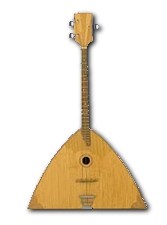 Balalaika
A popular Russian
Balalaika
A popular Russian folk family of guitars
folk family of guitars in various sizes. Triangular body with a fretted fingerboard and usually
with 3 strings. Can be played in large ensembles or to accompany singing
and dancing.
in various sizes. Triangular body with a fretted fingerboard and usually
with 3 strings. Can be played in large ensembles or to accompany singing
and dancing.
 Bandoneon
The chromatic German
Bandoneon
The chromatic German type of concertina
type of concertina which was invented by Heinrich Ban
in the 1840s, and is still popular in traditional tango
which was invented by Heinrich Ban
in the 1840s, and is still popular in traditional tango music. The Bandoneon has the same notes on the push and pull, but a different
fingering system than the concertina. Instead of a keyboard it has 75 buttons
producing single notes.
music. The Bandoneon has the same notes on the push and pull, but a different
fingering system than the concertina. Instead of a keyboard it has 75 buttons
producing single notes.
 Bombarde
Bombarde A large Shawm
A large Shawm .
Also called 'pommer'. .
Also called 'pommer'.
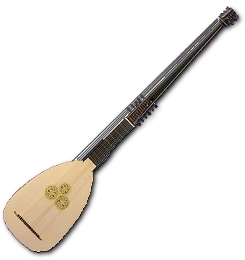 Chitarrone
Chitarrone A 16-17th century popular theorbo-like
A 16-17th century popular theorbo-like instrument, mostly used to accompany solo singing. Metal or gut strings
(six double courses over the fingerboard and eight single bass strings).
A descendant of the lute
instrument, mostly used to accompany solo singing. Metal or gut strings
(six double courses over the fingerboard and eight single bass strings).
A descendant of the lute . .
 Cimbalom
A Gipsy-Hungarian
Cimbalom
A Gipsy-Hungarian Dulcimer
Dulcimer which sometimes is also seen in the concert-hall, as it has been used in
works by Liszt
which sometimes is also seen in the concert-hall, as it has been used in
works by Liszt ,
Kodály ,
Kodály (in "Háry János")
and Bartók
(in "Háry János")
and Bartók . .
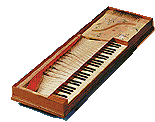 Clavichord
Developed in 14th century from
the monochord
Clavichord
Developed in 14th century from
the monochord ,
the clavichord was a small rectangular keyboard instrument with a small
dynamic range, therefore mostly used as a solo instrument. Sound is produced
by tangents striking the strings and remain in contact with the strings
while they are vibrating. Used throughout Western
Europe until the 18th century. ,
the clavichord was a small rectangular keyboard instrument with a small
dynamic range, therefore mostly used as a solo instrument. Sound is produced
by tangents striking the strings and remain in contact with the strings
while they are vibrating. Used throughout Western
Europe until the 18th century.
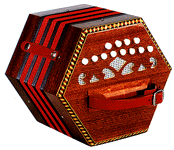 Concertina
Accordion-like
Concertina
Accordion-like with buttons for the fingers, instead of a keyboard. Consisting of two
hexagonal ends connected by bellows which are opened and closed by the
hands. An enormously popular instrument since the early 19th century, until
it was superseded by the accordion with the piano-like keyboard. Nowadays,
mostly played by folk musicians.
with buttons for the fingers, instead of a keyboard. Consisting of two
hexagonal ends connected by bellows which are opened and closed by the
hands. An enormously popular instrument since the early 19th century, until
it was superseded by the accordion with the piano-like keyboard. Nowadays,
mostly played by folk musicians.
 Cornett
A Renaissance
Cornett
A Renaissance woodwind instrument with finger-holes and a cup-shaped mouthpiece (similar
to a trumpet's mouthpiece). The name means 'little horn' and spelt with
double 't' to avoid confusion with the cornet
woodwind instrument with finger-holes and a cup-shaped mouthpiece (similar
to a trumpet's mouthpiece). The name means 'little horn' and spelt with
double 't' to avoid confusion with the cornet .
Made of ivory or wood and bound in leather. See also the German .
Made of ivory or wood and bound in leather. See also the German curved cornett which is called Zink
curved cornett which is called Zink . .
 Crumhorn
Crumhorn Double-reed family of wind instruments
in a few sizes of different pitch. Probably developed in Italy
Double-reed family of wind instruments
in a few sizes of different pitch. Probably developed in Italy in the late 15th century, the crumhorn became an important instrument in
the European
music of the 16th-17th centuries. The name means 'a curved horn'.
in the late 15th century, the crumhorn became an important instrument in
the European
music of the 16th-17th centuries. The name means 'a curved horn'.
 Curtal
A Renaissance
Curtal
A Renaissance wind instrument, with double reeds and conical bore. It was developed in
mid-16th century, and was the ancestor of the bassoon
wind instrument, with double reeds and conical bore. It was developed in
mid-16th century, and was the ancestor of the bassoon .
In addition to the bass, there were also soprano, alto, tenor and the bass
size curtal, which was known as double curtal. .
In addition to the bass, there were also soprano, alto, tenor and the bass
size curtal, which was known as double curtal.
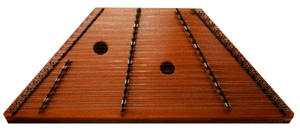 Dulcimer
Dulcimer  A string instrument of the box
zither
A string instrument of the box
zither family to be struck with a pair of light wooden hammers, held in the player's
hands. Probably derived from the psaltery
family to be struck with a pair of light wooden hammers, held in the player's
hands. Probably derived from the psaltery in Europe during
the late 15th century, it is still a popular folk instrument in Central
Europe and many other cultures
in Europe during
the late 15th century, it is still a popular folk instrument in Central
Europe and many other cultures all over the world.
all over the world.
 Fanfare, fanfare trumpet
Fanfare, fanfare trumpet Valveless instrument designed for
ceremonial purpose. The Chotzotzerah
Valveless instrument designed for
ceremonial purpose. The Chotzotzerah which is the silver trumpet used in the temple service in biblical times
("...use them for calling the community together and for having the
camps set out." - Numbers 10:2).
which is the silver trumpet used in the temple service in biblical times
("...use them for calling the community together and for having the
camps set out." - Numbers 10:2).
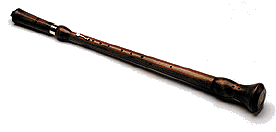 Glastonbury Pipe
Glastonbury Pipe This reed instrument is based on
a stone figure found in Glastonbury,
England
This reed instrument is based on
a stone figure found in Glastonbury,
England ,
an ancient Iron Age lake village. Glastonbury Abbey was also a place of
worship of Druids and an object of pilgrimages in the Middle
Ages ,
an ancient Iron Age lake village. Glastonbury Abbey was also a place of
worship of Druids and an object of pilgrimages in the Middle
Ages . .
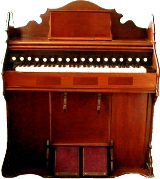  Harmonium, Reed organ
Mainly used to accompany hymns,
as a substitute for the organ
Harmonium, Reed organ
Mainly used to accompany hymns,
as a substitute for the organ ,
this is a small portable instrument of the reed-organ family, in which
pedals activate a bellows which drives air through the reeds. ,
this is a small portable instrument of the reed-organ family, in which
pedals activate a bellows which drives air through the reeds.
 Hautbois
The smaller member of the shawm
family, which was taken in the 17th century into English
Hautbois
The smaller member of the shawm
family, which was taken in the 17th century into English as 'oboe'
as 'oboe' . .
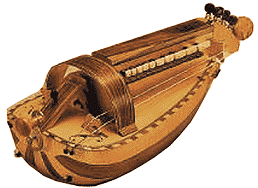
Hurdy-Gurdy / Viella a Roue / wheel
fiddle A stringed instrument with a keyboard
and a wheel cranked by a handle instead of the bowing action of the violin
A stringed instrument with a keyboard
and a wheel cranked by a handle instead of the bowing action of the violin .
It was found throughout Europe
since the 12th century. Mostly used for dance music. .
It was found throughout Europe
since the 12th century. Mostly used for dance music.
 Kettledrums
A cauldron-shaped drum; the most
familiar are the orchestral Timpani
Kettledrums
A cauldron-shaped drum; the most
familiar are the orchestral Timpani .
Often paired, they can be found in Arabic .
Often paired, they can be found in Arabic music as naqqara, in England
music as naqqara, in England as Nakers, in France
as Nakers, in France as nacaires and in the Indian
as nacaires and in the Indian Tabla
Tabla .
Kettledrums have been known since the 2000's BC in Mesopotamia
and were brought to Europe
during the Crusades in the 13th century. .
Kettledrums have been known since the 2000's BC in Mesopotamia
and were brought to Europe
during the Crusades in the 13th century.
 Lira da braccio
Lira da braccio A Renaissance
A Renaissance bowed string instrument, with a violin's
bowed string instrument, with a violin's body, a wide fingerboard and seven strings. Mostly used to provide a chordal
accompaniment. Superseded by the violin in the early 17th century.
body, a wide fingerboard and seven strings. Mostly used to provide a chordal
accompaniment. Superseded by the violin in the early 17th century.
Lira da gamba
A renaissance bowed string instrument played on the leg ('da gamba').
bowed string instrument played on the leg ('da gamba').
 Lute
Lute  Plucked string instrument, usually
played by plucking with the fingers. It is a descendant of the Arab
Plucked string instrument, usually
played by plucking with the fingers. It is a descendant of the Arab Oud
Oud (the word 'lute' is derived from the Arabic 'al-ud') and was brought to
Spain
(the word 'lute' is derived from the Arabic 'al-ud') and was brought to
Spain through the Moorish conquest and spread to all Europe,
where it has been a central instrument from the late Middle
Ages
through the Moorish conquest and spread to all Europe,
where it has been a central instrument from the late Middle
Ages to the 18th century.
to the 18th century.
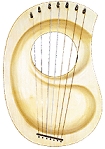 Lyre
Lyre Ancient string instrument with
the known examples from the 3rd millennium BC in Mesopotamia
and later in the Mediterranean.
The lyre was traditionally regarded as the instrument of King David in
the Bible. The lyre's descendant is the Welsh
plucked or bowed lyre, known as the Crwth.
Ancient string instrument with
the known examples from the 3rd millennium BC in Mesopotamia
and later in the Mediterranean.
The lyre was traditionally regarded as the instrument of King David in
the Bible. The lyre's descendant is the Welsh
plucked or bowed lyre, known as the Crwth.
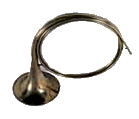 Natural Horn
Horn without valves, which can
produce only the notes of the harmonic series
Natural Horn
Horn without valves, which can
produce only the notes of the harmonic series ,
together with some obtained by placing the hand in the bell of the instrument.
Current in the 18th century. ,
together with some obtained by placing the hand in the bell of the instrument.
Current in the 18th century.
Oboe
d'amore
The alto of the oboe
of the oboe family. Commonly used in baroque
family. Commonly used in baroque music (as in J.S. Bach's
music (as in J.S. Bach's St Matthew Passion
St Matthew Passion ).
Pitched a minor 3rd below the normal oboe (in A). ).
Pitched a minor 3rd below the normal oboe (in A).
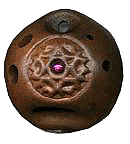  Ocarina
Ocarina  A wind instrument without keys
and the shape of an egg or potato, with small holes for the fingers. It
is made of earthenware clay or metal and can be found in all parts of the
world. The ceramic Ocarina is probably more than 12000 years old and its
origin is said to go back to a Mesopotamian primitive musical instrument
cuckoo whisle. The name means 'Little goose egg' in Italian
A wind instrument without keys
and the shape of an egg or potato, with small holes for the fingers. It
is made of earthenware clay or metal and can be found in all parts of the
world. The ceramic Ocarina is probably more than 12000 years old and its
origin is said to go back to a Mesopotamian primitive musical instrument
cuckoo whisle. The name means 'Little goose egg' in Italian ,
referring to the shape that was developed there in the 19th century.
In America ,
referring to the shape that was developed there in the 19th century.
In America ,
it became known as the "sweet potato" and it became so popular
that during World War ll the U.S. government issued ocarinas to its soldiers
as a morale booster. ,
it became known as the "sweet potato" and it became so popular
that during World War ll the U.S. government issued ocarinas to its soldiers
as a morale booster.
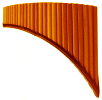 Pan pipe / Syrinx / Pan flute
Pan pipe / Syrinx / Pan flute  A medieval
A medieval folk instrument of classical antiquity, made of a series of short vertical
pipes fixed side by side and graduated in length in order to give a scale
when blown. The name is for the ancient Greek
folk instrument of classical antiquity, made of a series of short vertical
pipes fixed side by side and graduated in length in order to give a scale
when blown. The name is for the ancient Greek god Pan. Mozart
god Pan. Mozart used it in 'The Magic flute'
used it in 'The Magic flute' ('Die Zauberflöte') as the instrument of Papageno.
('Die Zauberflöte') as the instrument of Papageno.
 Portative organ
Portative organ![Musician Angels [detail] (1485) Hans Memling, Koninkijk Museum, Antwerp](../../arti.gif) Medieval
Medieval small organ
small organ which was carried by the player, with flue-pipes. Made from 1100-1650.
which was carried by the player, with flue-pipes. Made from 1100-1650.
 Post horn
A small brass instrument used in
the past for signalling by postilions, coachmen and guards. Without valves
or keys, it produces only the notes of one harmonic
series
Post horn
A small brass instrument used in
the past for signalling by postilions, coachmen and guards. Without valves
or keys, it produces only the notes of one harmonic
series .
It is sometimes circular but often in a straight unbent tube. Predecessor
of the cornet .
It is sometimes circular but often in a straight unbent tube. Predecessor
of the cornet . .
 Psaltery
Psaltery A popular medieval
A popular medieval string instrument, played by plucking with a plectra or the fingers, although
it can be also played with a bow. Its shape was influenced by its forerunner
- the Middle Eastern
qanun
string instrument, played by plucking with a plectra or the fingers, although
it can be also played with a bow. Its shape was influenced by its forerunner
- the Middle Eastern
qanun which entered Moorish Spain
which entered Moorish Spain and from there to other parts of Europe,
around the 12th century. The name might have derived from the Greek psallein
meaning plucked with fingers
and from there to other parts of Europe,
around the 12th century. The name might have derived from the Greek psallein
meaning plucked with fingers
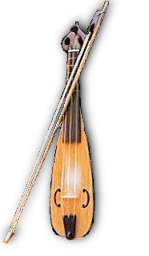 Rebec
A bowed stringed instrument used
in European art
music since the 8th century (from the Middle
Eastern rebab
Rebec
A bowed stringed instrument used
in European art
music since the 8th century (from the Middle
Eastern rebab or rabab) and during the Middle Ages
or rabab) and during the Middle Ages and Renaissance
and Renaissance .
In the Renaissance there were several sizes of the rebec: bass, tenor and
soprano. The number of the rebec's strings varied from 1 to 5 and even
more. .
In the Renaissance there were several sizes of the rebec: bass, tenor and
soprano. The number of the rebec's strings varied from 1 to 5 and even
more.
 Sackbut
Sackbut Early Trombone
Early Trombone ,
used between 15th-18th centuries, with a narrower bore than the modern
instrument. Derived from 'saqueboute' ('pull-push' in French ,
used between 15th-18th centuries, with a narrower bore than the modern
instrument. Derived from 'saqueboute' ('pull-push' in French ). ).
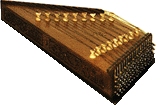 Santoor
A Persian
string instrument introduced to Indian
Santoor
A Persian
string instrument introduced to Indian classical music during the 15th century. Made of a wooden box, it has approximately
100 strings. A relative of the European
hammered dulcimer
classical music during the 15th century. Made of a wooden box, it has approximately
100 strings. A relative of the European
hammered dulcimer ,
the Chinese ,
the Chinese yang chin; and
the Hungarian
yang chin; and
the Hungarian cembalom.
cembalom.
 Serpent
Serpent Obsolete S-shaped wood horn
with fingerholes, bass member of the cornett
Obsolete S-shaped wood horn
with fingerholes, bass member of the cornett family. It is blown with a cup shaped mouthpiece which is very similar
to that of brass
family. It is blown with a cup shaped mouthpiece which is very similar
to that of brass instruments, such as the trombone
instruments, such as the trombone or Euphonium
or Euphonium .
Historically made from wood, although other materials such as brass were
also used. This very curved kind of cornett was invented in the 16th century
to double male voices in plainsong .
Historically made from wood, although other materials such as brass were
also used. This very curved kind of cornett was invented in the 16th century
to double male voices in plainsong ,
in Christian church music. ,
in Christian church music.
 Shawm / chalumeau / Schalmei
Shawm / chalumeau / Schalmei  A woodwind
A woodwind instrument, double-reeded forerunner of the oboe
instrument, double-reeded forerunner of the oboe .
It was much used from the late 13th to the 17th centuries. It is a family
of instruments in which the bombarde .
It was much used from the late 13th to the 17th centuries. It is a family
of instruments in which the bombarde is the largest. A relative to the sahnai
from India
is the largest. A relative to the sahnai
from India and the Middle Eastern
zurna
and the Middle Eastern
zurna . .
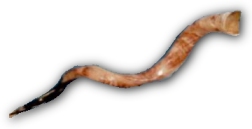 Shofar
The ram's horn of the Bible which
is still in use on the most solemn rituals in the Jewish synagogue, in
Israel
Shofar
The ram's horn of the Bible which
is still in use on the most solemn rituals in the Jewish synagogue, in
Israel and throughout the world. Produces only two notes.
and throughout the world. Produces only two notes.
 Side drums
Side drums British
British name for two of the Snare drums: a small drum which is slung slightly to
one side when marching. Played with wooden sticks. The earliest known side
drum was the tabor
name for two of the Snare drums: a small drum which is slung slightly to
one side when marching. Played with wooden sticks. The earliest known side
drum was the tabor . .
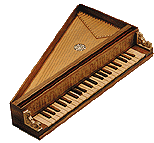 Spinet
Spinet  A wing-shaped keyboard
A wing-shaped keyboard instrument. A small type of harpsichord
instrument. A small type of harpsichord whose strings run diagonally.
whose strings run diagonally.
 Tabor
Tabor A small rope-tensioned drum with
snares, mostly used for rustic dance music, military music or as a background
music for jugglers. The medieval
A small rope-tensioned drum with
snares, mostly used for rustic dance music, military music or as a background
music for jugglers. The medieval tabor was the earliest known side drum
tabor was the earliest known side drum .
It was represented in early 13th and 14th century art. One performer can
accompany himself with the tabor by beating the drum with one hand while
the other hand plays a pipe. .
It was represented in early 13th and 14th century art. One performer can
accompany himself with the tabor by beating the drum with one hand while
the other hand plays a pipe.
 Theorboe / theorbo
Theorboe / theorbo Renaissance
Renaissance plucked instrument, first developed in Italy
plucked instrument, first developed in Italy around the end of the 16th century. A descendant of the lute with the characteristic
round back. Frequently used as an accompanying instrument and was much
used as a continuo
around the end of the 16th century. A descendant of the lute with the characteristic
round back. Frequently used as an accompanying instrument and was much
used as a continuo instrument in large ensembles. Apart from its extra (S-shaped) neck and
shorter neck it is almost identical with the Chitarrone
instrument in large ensembles. Apart from its extra (S-shaped) neck and
shorter neck it is almost identical with the Chitarrone . .
 Transverse flute / traverso
Transverse flute / traverso A name for the ordinary side-blown
flute
A name for the ordinary side-blown
flute (held crosswise) from the end-blown recorder
(held crosswise) from the end-blown recorder (which held downwards).
(which held downwards).
 Vihuela
Vihuela Spanish
Spanish Renaissance
Renaissance Guitar-like plucked instrument, strung like the lute
Guitar-like plucked instrument, strung like the lute .
Superseded by the guitar .
Superseded by the guitar in the 17th century. The word also seemed to apply to many kinds of string
instruments in the Renaissance but usually referred to the vihuela de
mano which was played with the hand, instead of a bow or a plectrum.
in the 17th century. The word also seemed to apply to many kinds of string
instruments in the Renaissance but usually referred to the vihuela de
mano which was played with the hand, instead of a bow or a plectrum.
 Viola da Gamba / viol
Viola da Gamba / viol  Bowed stringed instrument of various
sizes, superseded by the violins
Bowed stringed instrument of various
sizes, superseded by the violins .
Sometimes specifically applied to the bass
viol .
Sometimes specifically applied to the bass
viol .
All family members are called viola 'da gamba' (for the leg) as they are
rested between or on the legs. The viols' frets and shape is the most important
difference from the violin family. .
All family members are called viola 'da gamba' (for the leg) as they are
rested between or on the legs. The viols' frets and shape is the most important
difference from the violin family.
Viola da braccio
Arm violin. Renaissance bowed string instrument, played on the arm.
bowed string instrument, played on the arm.
 Virginal
Virginal  A small type of harpsichord
A small type of harpsichord whose strings run parallel to the keyboard. It has the shape of a clavichord
whose strings run parallel to the keyboard. It has the shape of a clavichord but its metal strings produce the sound of a harpsichord. Also known is
the double virginal, in which two keyboards are superimposed and played
separately or coupled.
but its metal strings produce the sound of a harpsichord. Also known is
the double virginal, in which two keyboards are superimposed and played
separately or coupled.
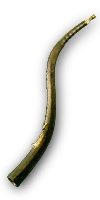 Zink
Zink German
German name for the cornett
name for the cornett .
It is a Renaissance .
It is a Renaissance great virtuoso wind instrument used in serious and dance music. Combines
a trumpet
great virtuoso wind instrument used in serious and dance music. Combines
a trumpet mouthpiece with a wooden or ivory tube. The sound of the zink is very close
to the sound of a human voice and can be played very softly or as loud
as a brass
mouthpiece with a wooden or ivory tube. The sound of the zink is very close
to the sound of a human voice and can be played very softly or as loud
as a brass instrument.
instrument.
 Zither
Zither A family of string instruments
descendant of medieval
A family of string instruments
descendant of medieval psaltery, prevalent in Austria
psaltery, prevalent in Austria and Bavaria.
Strings are plucked by the fingers of either hand. The Zithers are usually
hammered (as in the dulcimer
and Bavaria.
Strings are plucked by the fingers of either hand. The Zithers are usually
hammered (as in the dulcimer )
or plucked (the psaltery )
or plucked (the psaltery ),
but the hurdy-gurdy ),
but the hurdy-gurdy ,
which is bowed with a wheel, and the blown aeolian
harp. The German ,
which is bowed with a wheel, and the blown aeolian
harp. The German autoharp is an adaptation from the late 19th century.
autoharp is an adaptation from the late 19th century.
|